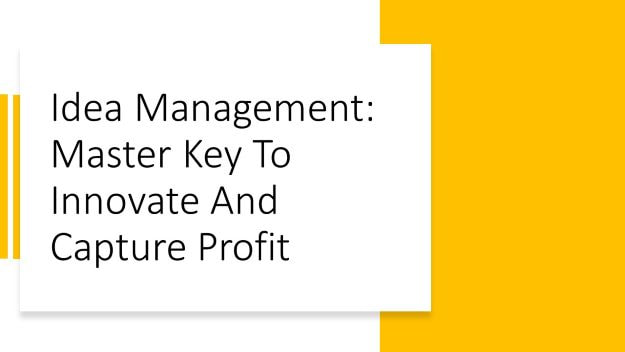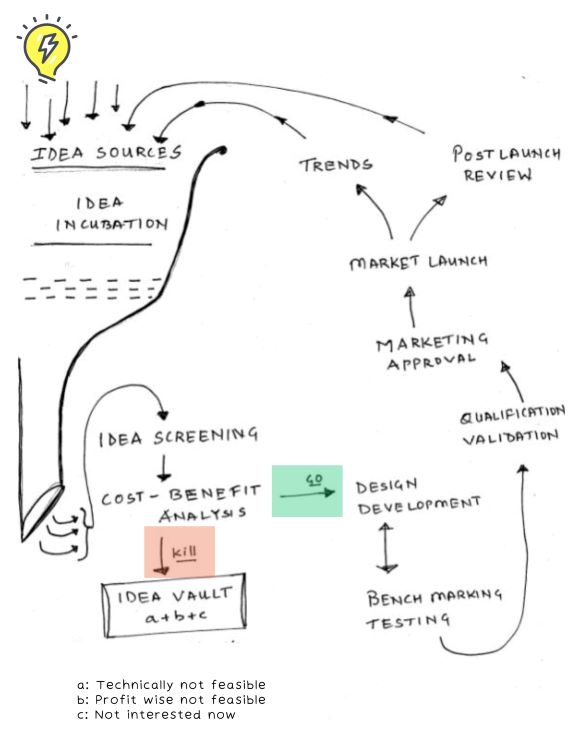Out-of-the-box thinking as the name suggests is seamless creativity. While inside-the-box thinking means there is a boundary within which ideas are generated and managed. Wider the boundary, deeper gets the creativity.
And if more ideas have to grow from being on paper to becoming a commercialized product, inside-the-box thinking is the way to go.
Because, for a business there is a budget to follow, expenses to limit, ROI to gain and investors to take care of. Every penny spent on innovation is accounted for i.e. where profits aren’t earned, the R&D expenditure gets written-off. And the objective is always to get the most out of the buck.
Inside-the-box thinking essentially means, innovation is done with a target product profile in mind. The aim is to generate large number of ideas to maximize number of potential ideas-to-product pathways. The picture below depicts innovation management via inside-the-box idea generation.
Once an idea qualifies for becoming a new product candidate, it must successfully pass through the various stages of product development thru obtaining market approval and subsequent launch, to find its crown in the marketplace.
Let's analyze the ideas further- Usually, ideas get rejected because of three main reasons-
a. Technically idea commercialization is not possible.
b. Profit wise the ideas are not feasible.
c. The company is not keen to go for such a new product at this point of time.
Hence, let's first segregate the rejected ideas into three buckets as per the above classification and then review them one-by-one.
A. Technically idea commercialization is not possible.
A classic example of this is Sildenafil citrate tablet. This drug candidate was first evaluated as a treatment for chest-pain. Later, the company found an alternate use of the drug candidate and channeled this molecule thru the development pipeline to launch as Viagra- rest is history!
B. Profit wise the ideas are not feasible
One of the classic example for this is- the Microwave oven.
Microwave oven was first invented in the 1940s, around world war II era. The first commercialized microwave oven was huge, weighing 750 pounds and costed $2000 USD. Obviously, it did not sell well.
The company worked on the technical aspects and the first domestic microwave was introduced in 1955. And that did not sell too. After many design changes, microwave oven gained access to our homes in 1967 and by 1975, they were in full demand.
A point to note here is that microwave oven invention was both accidental and EVOP (Evolutionary Operation) product development. Also, note the development timeline, from 1940 to 1955 to 1967 to 1975. i.e. 27 to 35 years from being an 'idea' to 'profitable' commercialization!
It is well-known that EVOP drains money. To avoid such bleed, concept of Innovation Management took shape. I shall be writing more about innovation management in a separate blogpost. For now let us visit the third lot of rejected ideas.
C. Company is not keen to go for such a new product at this point of time:
Such ideas must be worked upon in the lab to develop a small prototype. While prototyping, ensure that you build-in anti-counterfeit measures in your product. Then file a provisional patent application to stake claim to your idea and simultaneously block competition.
After filing a provisional patent application, you have 12 months to file final PCT patent specification. Additionally, you get thirty months (from date of priority filing) to enter national phase i.e. do national phase patent applications in the PCT countries of your choice.
Hence, the company gets close to 30 months to scout for buyers who would be interested to license your product. Since a prototype as well as the patent is available (for the invention), you stand to gain better licensing fees at the negotiation table.
Also, resources need not be pumped-in immediately, as product development, process validation, scale-up and other related activities can take place over 12 to 30 months timeframe. This has dual advantages- first, R&D budget can be better managed, and second, R&D infrastructure can be better utilized.
Moreover, provisional and/or final PCT patents being intellectual property can be mortgaged on a short-term basis to banks or other financial institutions, to secure funds which in turn may be pumped-in to conduct research work or use it for other areas of the business.
The philosophy of Innovation Management is to ensure, every penny spent on R&D must bring-in good return on investment (ROI) both in terms of profits and company reputation.
The goal of Innovation Management is to turn ideas into profit, block competition and stop counterfeits. |
There are multiple pathways for conducting idea and innovation management successfully. The content presented above is one such pathway.
Also, the choice of idea and innovation management pathways depend on various factors such as- industry vertical, product mix, operating markets, corporate goals and more. Therefore, selecting the best pathway which will yield faster ROI with a first-mover advantage is crucial.
Your choice of idea and innovation management pathway and its flawless execution will determine your business's very existence, growth and resilience.
An important question to introspect is- Are you building an idea and innovation management strategy which is the best for your organization?
To know more about how idea-innovation management can help your company expand its product offerings, increase profit and earnings per share for investors, reach out to Shruti.
Related Reading:
- Disaggregate between being lucky and being good in business: Portfolio Management and Continuous Improvement are the two winning tools in the new normal …
- 8 Steps to becoming a Customer- centric organization
- Dos and Don’ts Of Rapid Innovation
- How to transform businesses via portfolio management- Part 1
- How to cut costs strategically using Kaizen
Follow Shruti on Twitter, Facebook, YouTube, LinkedIn
Categories: Innovation Management | Operational Excellence
Keywords and Tags:
#innovationmanagement #patent #ideamanagement #stopcounterfeits #blockcompetition






















